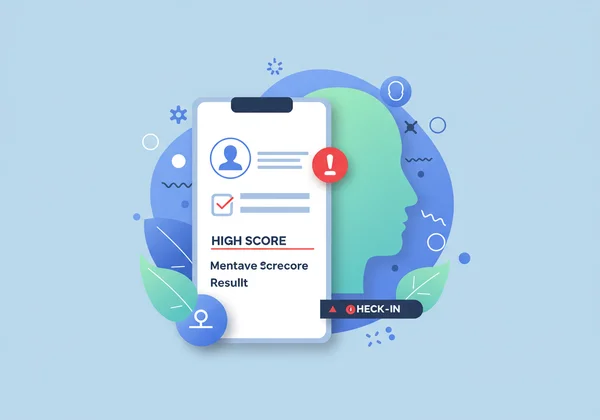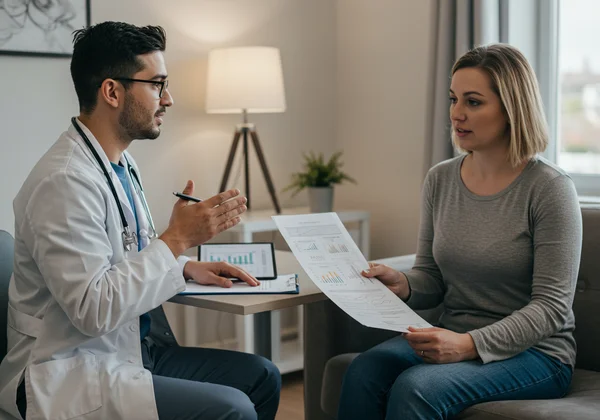High EPDS Score? Your Next Steps for Perinatal Support
First, let's acknowledge the courage it took to check in with your emotional well-being. Taking an EPDS (Edinburgh Postnatal Depression Scale) screening is a powerful act of self-awareness. If your results showed a high score, you might feel a mix of concern, confusion, and maybe even validation. You may be wondering, What to do after a high EPDS score? This guide is here to walk you through that question with clarity and compassion. Remember, this score is not a final word on your health; it is a starting point, a signal to explore further. You've already taken a brave step, and we're here to help you navigate what comes next.
Understanding Your High EPDS Score & What It Means
Receiving a high score on the epds score interpretation can feel daunting, but it's essential to frame it correctly. The EPDS is a highly respected screening tool used worldwide to identify mothers who may be at risk for perinatal depression. It is not designed to diagnose, but rather to highlight symptoms that warrant a closer look. A high score simply means that the feelings you've been experiencing are significant and deserve attention from a healthcare professional.
Think of it like a smoke detector. When it beeps, it doesn't mean the house is burning down, but it signals that you need to check for a fire. Similarly, your EPDS score is an alert. It’s an invitation to have a conversation and get the support you need during this transformative period of life, whether during pregnancy or postpartum.

What Constitutes a High EPDS Score?
While different clinical settings may use slightly different cutoffs, understanding your score is a key step. Generally, a score of 10 or above on the EPDS scale suggests the presence of depressive symptoms that should be discussed with a doctor or mental health professional. A score of 13 or higher often indicates a high likelihood of experiencing clinical depression.
It's particularly important to pay attention to your answer for question 10, which addresses thoughts of self-harm. Any score above zero on this specific question requires immediate attention and discussion with a healthcare provider, regardless of your total score. The goal here is not to cause alarm but to ensure your safety and well-being, which are paramount.
Interpreting High EPDS Scores
It's crucial to understand: the EPDS is a call to action, not a clinical diagnosis. The tool, developed by Cox, Holden, and Sagovsky in 1987, is a questionnaire designed to open a dialogue. Many factors can influence your score, including sleep deprivation, physical recovery from childbirth, and the immense hormonal shifts you experience. These are all part of the perinatal picture.
Your score is a piece of valuable information—a snapshot of your emotional state over the past seven days. It gives you a concrete way to start a conversation with someone who can help. You can use your results as a guide to articulate your feelings when you seek professional help.
Taking Action: Your Immediate Next Steps After a High EPDS Score
Seeing a high number can be overwhelming, but your epds next steps are clear and manageable. The most important thing is to move from awareness to action. This is a moment to be proactive and build on the brave step you've already taken. Let's break down what to do now.
This is your opportunity to advocate for your mental health. Taking these next steps is a sign of strength and a commitment to yourself and your family. Remember, you do not have to navigate this alone; resources and professionals are ready to help you on your path to feeling better.
Prioritize Your Safety: When to Seek Urgent Help
Before anything else, let’s talk about immediate emotional support. If your score was high and particularly if you indicated any thoughts of harming yourself on question 10 of the EPDS questionnaire, your safety is the number one priority. These thoughts can be a frightening symptom of perinatal depression, and they are a clear sign to seek help immediately.
Do not wait to schedule an appointment. Please contact a local crisis line, go to the nearest emergency room, or call your country's emergency services (like 911 in the US). There are people available 24/7 who are trained to support you through these moments. Reaching out for urgent help is the bravest and most important step you can take if you feel you are in crisis.
How to Talk to Your Healthcare Provider
For many, the next step is to seek help ppd (postpartum depression) from a trusted professional. This could be your OB/GYN, a primary care physician, a midwife, or a mental health therapist. Schedule an appointment and be prepared to share your EPDS score.
Here are a few tips to make that conversation easier:
-
Bring Your Results: Show them your score. If you used our online tool, you can bring the results page or the AI-powered report for a more detailed overview.
-
Be Specific: Instead of just saying "I feel sad," try to describe your symptoms. For example, "I've been crying every day," or "I'm not enjoying things I used to love."
-
Write It Down: It’s easy to forget things when you're feeling overwhelmed. Make a list of your feelings, symptoms, and any questions you have.
-
Be Honest: Your provider is there to help, not to judge. Be open about what you're experiencing, including any difficult or scary thoughts.

Building Your Perinatal Support Network
While professional medical advice is crucial, building a strong perinatal support network is equally vital for your recovery. This network includes practical, emotional, and social support systems that can help you cope with the day-to-day challenges of pregnancy and new parenthood while managing your mental health.
This is about creating a safety net of people and practices that lift you up. It’s about recognizing that you don’t have to do everything on your own. Leaning on your support system is not a weakness; it's a key strategy for resilience and well-being.
Self-Care Strategies You Can Start Today
When you're struggling, "self-care" can feel like another item on an impossible to-do list. However, new parent self-care doesn't have to be complicated. It's about small, consistent actions that protect your well-being.
Consider these simple strategies:
-
Prioritize Rest: Sleep when the baby sleeps, even if it's just for 20 minutes. Ask your partner or a family member to watch the baby so you can get a longer stretch of sleep.
-
Nourish Your Body: Try to eat regular, nutritious meals. Even a simple snack can help stabilize your mood and energy levels.
-
Gentle Movement: A short walk outside can do wonders for your mental state. Fresh air and a change of scenery can be incredibly restorative.
-
Lower Your Expectations: You don't have to be a perfect parent or have a spotless house. Give yourself permission to be "good enough."

Involving Your Partner and Family in Your Journey
When you're ready, sharing your journey with your partner, a close friend, or a family member can be a huge relief. They care about you, but they may not know how to help unless you tell them. Let them know what you’re going through and what you need.
Be specific with your requests. Instead of saying, "I need help," try saying, "Could you hold the baby for an hour so I can take a shower?" or "Could you bring over a meal tomorrow?" People often want to help but feel unsure of how to do so. Clear communication is key to getting the support you deserve.
Connecting with Local & Online Support Groups
Sometimes, the most powerful support comes from finding community with others who truly understand what you're experiencing. Connecting with other mothers who have navigated perinatal depression or anxiety can reduce feelings of isolation and shame. Hearing their stories can provide hope and practical advice.
Look for local postpartum support groups in your area, often run through hospitals or community centers. Online communities and organizations like Postpartum Support International (PSI) also offer incredible resources, including virtual support groups that you can join from the comfort of your home.
Your Path Forward
Remember, a high EPDS score is a signpost, not a final destination. It's an indicator that your mental health needs and deserves attention. By taking the screening, you have already demonstrated immense strength. The next steps—seeking professional help, building your support network, and practicing self-compassion—are all part of your journey toward healing and well-being. Your mental health is a vital part of your overall health, especially during the perinatal period.
You are not alone in this experience, and help is readily available. Continue to advocate for yourself. If you’re just starting or want to re-evaluate your feelings, start your screening today. Let it be the first of many steps you take to prioritize you. We encourage you to share your journey or thoughts in the comments below to help others who may be feeling the same way.
Frequently Asked Questions About EPDS Scores & Next Steps
What is a normal EPDS score?
A score of 0 to 9 is generally considered within the "normal" or low-risk range, suggesting a lower likelihood of significant depressive symptoms. However, any concerns, regardless of the score, should be discussed with a healthcare provider. The EPDS is a personal tool to help you understand your feelings.
Does the EPDS test screen for anxiety?
While the Edinburgh Postnatal Depression Scale is designed primarily to screen for symptoms of depression, some of the questions can also indicate the presence of anxiety. Many mothers experience both depression and anxiety concurrently. A high score can be a prompt to discuss both possibilities with your doctor.
Is the online EPDS test free to use?
Yes, our online EPDS screening is completely free, confidential, and accessible. Our goal is to remove barriers so that every new and expectant parent can check in on their mental health easily and privately. You can explore our platform without any cost or obligation.
How long does the online EPDS test take to complete?
The test is designed to be quick and straightforward. Most users complete the 10-question screening in just 3 to 5 minutes. We understand that your time is precious, so we've made the process as efficient as possible. You can try our free tool anytime to get immediate, confidential results.